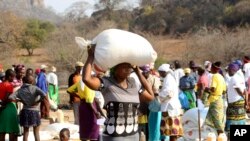The World Food Program says it needs US$220 million to provide assistance to an estimated 2,2 million Zimbabweans until 2017.
Labor and Social Services Minister Prisca Mupfumira says the number of people in need of food assistance has risen to more than four million. But the WFP says three million is still the official figure as it is yet to carry out another assessment.
The WFP says its seasonal relief, designed to help vulnerable people through the difficult pre-harvest months, usually runs from October to March. This year – for the first time ever – the program will continue running throughout the year and into next year.
In a press statement Wednesday, the WFP said, “Vulnerable people in Zimbabwe will continue to receive relief assistance from the United Nations’ World Food Programme through what is usually a period of bounty but which this year has turned into a time of want. WFP is extending its relief programme due to the punishing impact of El Niño on the food security of the country.”
The world’s largest humanitarian agency says this month it is providing food and cash-based assistance to some 730,000 vulnerable people. The focus is on the rural areas.
“Many rural communities are in the grip of hunger and this is set to continue into next year,” said Eddie Rowe, WFP Country Director in Zimbabwe.
He added that “we’re working with the government and donors to mobilize assistance to the most vulnerable but to reach all those in need we are dependent on the donor community continuing to fund our operations.”
The humanitarian agency says Zimbabwe’s high level of food insecurity is due to last year’s bad harvest – 50 percent down on that of the previous year – combined with an unusually strong El Niño weather event which has resulted in reduced rains for southern Africa.
Coinciding as it has with the main part of the growing season, El Niño-related drought has been disastrous for smallholder farmers dependent on rain-fed agriculture.
The WFP says it grateful for contributions already received from the Government of Zimbabwe as well as Canada, Switzerland, the UN Central Emergency Response Fund and the United States.
WFP Communications Officer for Southern Africa David Orr said, “I would say of course we are grateful to the assistance we are getting so far. This is not just a crisis in Zimbabwe but across the region we have very high levels of food insecurity nearly 30 million including South Africa.”
Malnutrition
According to the United Children’s Education Fund or Unicerf, Zimbabwe currently faces its worst malnutrition rates in 15 years, with 33,000 children in urgent need of treatment for severe acute malnutrition.
“Children are enduring the greatest force of this crisis,” said Unicef acting representative, Jane Muita.
“We have not seen these levels of malnutrition in more than 15 years and although the government and its partners are doing their best to assist, more needs to be done to prevent this crisis from spiraling out of control.”
State of Disaster
President Robert Mugabe, declared a state of disaster in rural areas hit by a severe drought early last month. A regional drought worsened by the El Niño weather phenomenon has affected South Africa, Malawi and Zambia as well as Zimbabwe, leaving tens of thousands of cattle dead, reservoirs depleted and crops destroyed.
Local Government Minister, Saviour Kasukuwere, released a statement on behalf of Mr. Mugabe declaring the state of disaster. "Given the foregoing ... His Excellency, the President has declared a state of disaster to severely affected areas in communal and resettlement lands of Zimbabwe effective from Feb. 2, 2016."
Opposition legislators had been calling for President Mugabe to make the declaration since last year when it became apparent that the country was not going to meet its food requirements after harvesting only 700,000 tonnes of grain against a national requirement of 1,8 million tonnes.






